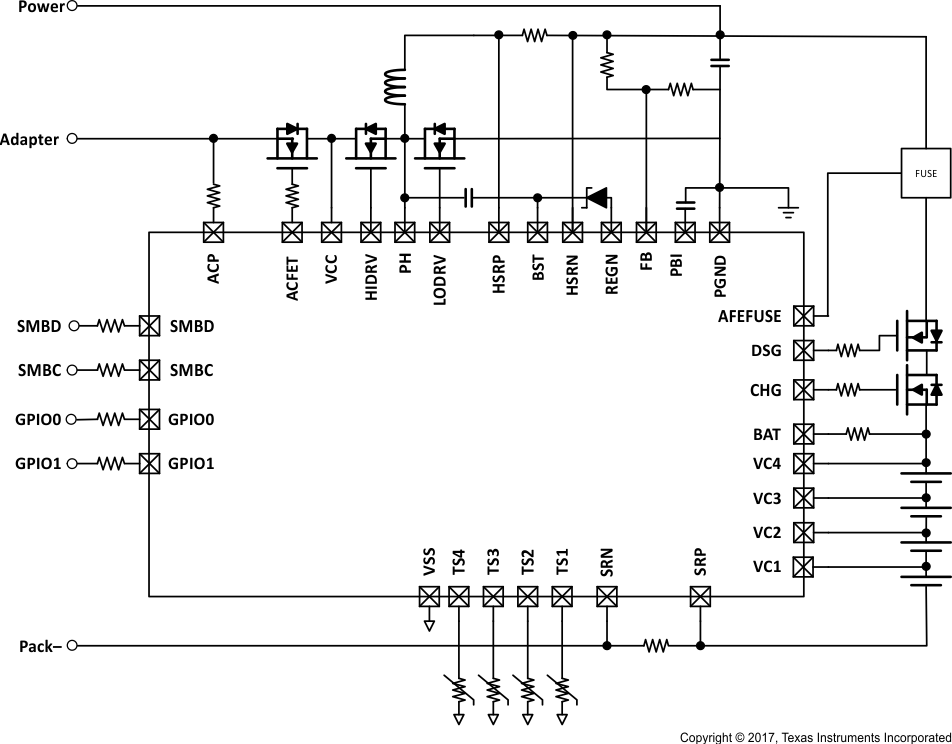SLUSAW3D December 2014 – January 2017
PRODUCTION DATA.
- 1 Features
- 2 Applications
- 3 Description
- 4 Revision History
- 5 Description (continued)
- 6 Pin Configuration and Functions
-
7 Specifications
- 7.1 Absolute Maximum Ratings
- 7.2 ESD Ratings
- 7.3 Recommended Operating Conditions
- 7.4 Thermal Information
- 7.5 Supply Voltage
- 7.6 Supply Current
- 7.7 Power Supply Control
- 7.8 Low-Voltage General Purpose I/O (TSx)
- 7.9 High-Voltage General Purpose I/O (GPIO0, GPIO1)
- 7.10 AFE Power-On Reset
- 7.11 Internal 1.8-V LDO
- 7.12 Current Wake Comparator
- 7.13 Coulomb Counter
- 7.14 CC Digital Filter
- 7.15 ADC
- 7.16 ADC Digital Filter
- 7.17 ADC Multiplexer
- 7.18 Cell Balancing Support
- 7.19 Cell Detach Detection
- 7.20 Internal Temperature Sensor
- 7.21 NTC Thermistor Measurement Support (ADCx)
- 7.22 High-Frequency Oscillator
- 7.23 Low-Frequency Oscillator
- 7.24 Voltage Reference 1
- 7.25 Voltage Reference 2
- 7.26 Instruction Flash
- 7.27 Data Flash
- 7.28 Current Protection Thresholds
- 7.29 N-CH FET Drive (CHG, DSG)
- 7.30 FUSE Drive (AFEFUSE)
- 7.31 Battery Charger Voltage Regulation (VFB)
- 7.32 Battery Charger Current Sense (HSRP, HSRN)
- 7.33 Battery Charger Precharge Current Sense (HSRP, HSRN)
- 7.34 AC Adapter Fault Detect (HSRN, VCC)
- 7.35 Battery Charger Overcurrent Detection (V)HSRP, (V)HSRN
- 7.36 Battery Charger Undercurrent Detection (V)HSRP, (V)HSRN
- 7.37 System Operation Detection (V)HSRN
- 7.38 Battery Overvoltage Comparator (VFB)
- 7.39 Regulator (REGN)
- 7.40 PWM High-Side Driver (HiDRV)
- 7.41 PWM Low-Side Driver (LoDRV)
- 7.42 PWM Information
- 7.43 Charger Power-Up Sequence
- 7.44 Thermal Shutdown Comparator
- 7.45 SMBus High Voltage I/O
- 7.46 SMBus
- 7.47 SMBus XL
- 7.48 Timing Requirements
- 7.49 Typical Characteristics
-
8 Detailed Description
- 8.1 Overview
- 8.2 Functional Block Diagram
- 8.3 Feature Description
- 9 Application and Implementation
- 10Power Supply Recommendations
- 11Layout
- 12Device and Documentation Support
- 13Mechanical, Packaging, and Orderable Information
パッケージ・オプション
メカニカル・データ(パッケージ|ピン)
- RHB|32
サーマルパッド・メカニカル・データ
- RHB|32
発注情報
1 Features
- Fully Integrated 2-Series to 4-Series Cell Li-Ion or Li-Polymer Battery Management Unit
- Input Voltage Range on Pack+: 2.5 V to 25 V
- Battery Charger Efficiency > 92%
- Battery Charger Operation Range: 4 V to 25 V
- Battery Charger, 1-MHz Synchronous Buck Controller for External NFETs
- Soft Start to Limit In-Rush Current
- Current Limit Protection for External Switches
- Programmable Charging
- Supports JEITA/Enhanced Charging Modes
- Fuel Gauging
- High Resolution 16-Bit Integrator for Coulomb Counter
- ADC, 16-Bit for Precision V, I, and T Measurements with 16-Channel Multiplexer
- Support for Simultaneous CC and ADC Sampling (Power Conversion)
- Supports Two-Wire SMBus v2.0 Interface with Accelerated 400-kHz Programming Option
- SHA-1 Hash Message Authentication Code (HMAC) Responder for Increased Battery Pack Security
- Split Key (2 × 64) Stored in Secure Memory
- Supports Field Updates
- AFE Protection
- Programmable Current Protection
- Overcurrent in Discharge
- Short-Circuit Current in Charge
- Short-Circuit Current in Discharge
- Programmable Current Protection
- N-FET High-Side Protection FET Drive
- Support for Four LEDs
- Thermistor inputs for NTC
- Compact 32-Pin QFN Package (RHB)
2 Applications
- Notebooks, Ultrabooks, Netbooks, Tablets, UMPCs
- Medical and Test Equipment
- Portable Instrumentation
3 Description
The Texas Instruments bq40z60 device is a Programmable Battery Management Unit that integrates battery charging control output, gas gauging, and protection for completely autonomous operation of 2-series to 4-series cell Li-Ion and Li-Polymer battery packs. The architecture enables internal communication between the fuel gauging processor and battery charger controller to optimize the charging profile based on the external load conditions and power path source management during load transients and adaptor current limitations in the system. The charging current efficiency is scalable for power transfer based on the external components, such as the NFETs, inductor, and sensing resistor.
Device Information(1)
| PART NUMBER | PACKAGE | BODY SIZE (NOM) |
|---|---|---|
| bq40z60 | VQFN (32) | 5.00 mm × 5.00 mm |
- For all available packages, see the orderable addendum at the end of the data sheet.
4 Revision History
Changes from C Revision (July 2015) to D Revision
- Changed Simplified SchematicGo
- Changed Pin Configuration and FunctionsGo
- Changed Absolute Maximum Ratings Go
- Changed Recommended Operating Conditions Go
- Changed High-Voltage General Purpose I/O (GPIO0, GPIO1) Go
- Changed Detailed Description Overview Go
- Changed Functional Block Diagram Go
- Changed Internal Power Source SelectionGo
- Changed Power Path Overview Go
- Changed Typical Application Schematic Go
